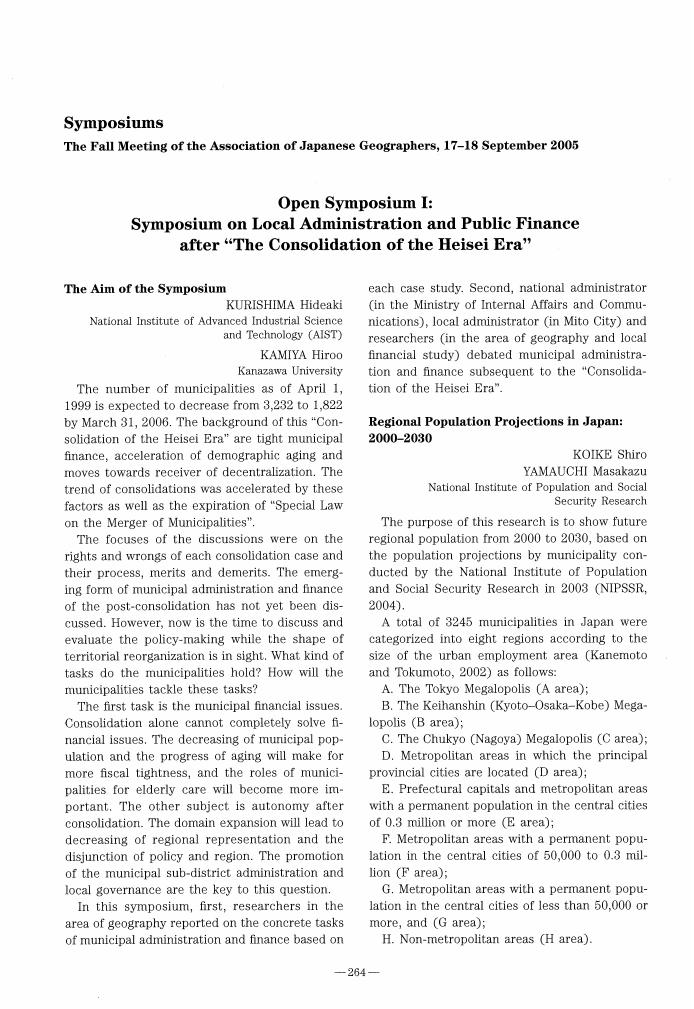- 著者
- Shin KAJITA
- 出版者
- The Association of Japanese Geographers
- 雑誌
- Geographical review of Japan, Series B (ISSN:02896001)
- 巻号頁・発行日
- vol.74, no.2, pp.147-158, 2001-12-01 (Released:2008-12-25)
- 参考文献数
- 27
- 被引用文献数
- 1
This paper aims to summarize the mechanisms of public investment as a social policy in remote rural areas in Japan. It includes findings from former studies as well as a case study undertaken in Shimane by the author, and it discusses the function of public investment in terms of the relationship between the three major groupings involved in the local civil engineering industry. These groups are the “primary labor force group” (PLG) which consists of workers born before or in 1935, the “secondary labor force group” (SLG) which consists of workers born after 1935, and the “local civil engineering companies” (LCECs). In the 1970s and 1980s. there was a strong mutual dependence between the PLG and the LCECs in remote rural areas. PLG workers gave higher priority to maintaining a traditional rural lifestyle and hoped to find jobs in their local area, hence jobs for them should have been created through public works projects. The LCECs also wanted a cheap and quantitatively flexible labor force for public works projects, so public investment worked effectively as a regional social policy. However, as the PLG workers retired and a new generation of workers entered the work force, the disparity between the supply of and demand for labor in the civil engineering industry has increased and the role of public investment as a social policy has been weakened. These changes suggest that the so-called “kaso problem” is generation-specific and that public investment as a social policy for remote rural areas is nearing its end.
- 著者
- Hideaki KURISHIMA Hiroo KAMIYA Shiro KOIKE Masakazu YAMAUCHI Shin KAJITA Teruo HATAKEYAMA Kaoru MITANI Tadahiko MUSHA
- 出版者
- The Association of Japanese Geographers
- 雑誌
- 地理学評論 (ISSN:13479555)
- 巻号頁・発行日
- vol.79, no.5, pp.264-267, 2006-04-01 (Released:2008-12-25)
1 0 0 0 OA Environmental and Regional Revitalization
- 著者
- Shuji KITAMURA Toshifumi SHIWAKU Toshihisa ASANO Hideaki KURISHIMA Shin KAJITA Michio AKIYAMA
- 出版者
- The Association of Japanese Geographers
- 雑誌
- 地理学評論 (ISSN:13479555)
- 巻号頁・発行日
- vol.77, no.5, pp.370-374, 2004-04-01 (Released:2008-12-25)
1 0 0 0 OA Local Administration Reforms and Geography
- 著者
- Hiroo KAMIYA Shin KAJITA Kaoru MITANI Shin KAJITA Hiroo KAMIYA Hideaki KURISHIMA Shin'ichiro SUGIURA Yoko IIJIMA
- 出版者
- The Association of Japanese Geographers
- 雑誌
- 地理学評論 (ISSN:13479555)
- 巻号頁・発行日
- vol.76, no.5, pp.414-418, 2003-04-01 (Released:2008-12-25)


